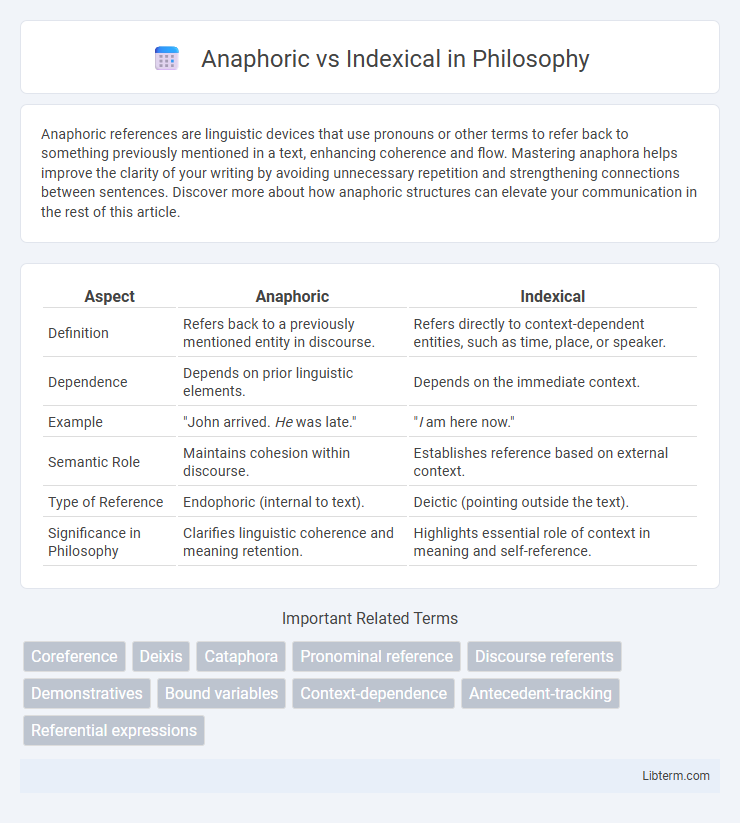Anaphoric references are linguistic devices that use pronouns or other terms to refer back to something previously mentioned in a text, enhancing coherence and flow. Mastering anaphora helps improve the clarity of your writing by avoiding unnecessary repetition and strengthening connections between sentences. Discover more about how anaphoric structures can elevate your communication in the rest of this article.
Table of Comparison
| Aspect | Anaphoric | Indexical |
|---|---|---|
| Definition | Refers back to a previously mentioned entity in discourse. | Refers directly to context-dependent entities, such as time, place, or speaker. |
| Dependence | Depends on prior linguistic elements. | Depends on the immediate context. |
| Example | "John arrived. He was late." | "I am here now." |
| Semantic Role | Maintains cohesion within discourse. | Establishes reference based on external context. |
| Type of Reference | Endophoric (internal to text). | Deictic (pointing outside the text). |
| Significance in Philosophy | Clarifies linguistic coherence and meaning retention. | Highlights essential role of context in meaning and self-reference. |
Introduction to Anaphoric and Indexical Expressions
Anaphoric expressions refer back to previously mentioned entities within a discourse, creating cohesion by linking elements such as pronouns or definite descriptions to antecedents. Indexical expressions depend on the context of utterance, including words like "I," "here," and "now," whose meanings shift based on the speaker, time, or place. Understanding the distinction between anaphoric and indexical expressions is essential for semantic analysis as it clarifies how meaning is constructed in context-dependent and context-independent references.
Defining Anaphora: Meaning and Usage
Anaphora is a linguistic device where a word or phrase refers back to another word or phrase used earlier in the discourse, creating cohesion and avoiding repetition, commonly seen with pronouns like "he," "she," or "it." Unlike indexicals, which depend on the speaker's context for interpretation, anaphoric expressions rely solely on prior textual elements for meaning resolution. Understanding anaphora is essential for computational linguistics and natural language processing to enhance text comprehension and anaphora resolution algorithms.
Understanding Indexicals: Features and Examples
Indexicals are expressions whose reference shifts depending on the context of utterance, such as pronouns like "I," "you," and temporal adverbs like "now" and "today." Key features include context-sensitivity, where the meaning relies on the speaker, time, or location, and they lack a fixed referent independent of context. For example, "I am here now" refers dynamically to the speaker at the moment of speaking, illustrating the essential role of context in interpreting indexicals accurately.
Key Differences Between Anaphoric and Indexical References
Anaphoric references depend on a previously mentioned element within the discourse, such as pronouns referring back to a noun introduced earlier, establishing coherence through anaphora. Indexical references rely on context, pointing directly to elements in the physical or situational environment, like "here," "now," or "you," whose meanings shift depending on the speaker and time. The key difference lies in anaphoric references being context-internal and dependent on linguistic antecedents, while indexicals are context-external, anchored in the immediate situational context.
Linguistic Functions of Anaphoric Expressions
Anaphoric expressions serve the crucial linguistic function of referring back to previously mentioned entities within a discourse, ensuring coherence and continuity in communication. They facilitate efficient information retrieval by linking pronouns or noun phrases to antecedents, reducing redundancy and enhancing interpretability. Unlike indexicals, which depend on the situational context for meaning, anaphoric expressions rely solely on discourse context for their referential interpretation.
Pragmatic Roles of Indexicals in Communication
Indexicals play a crucial pragmatic role by directly linking expressions to their contextual parameters, such as speaker, time, and place, enabling precise reference in communication. Unlike anaphoric expressions that depend on prior discourse for meaning, indexicals dynamically derive significance from the immediate speech context, facilitating real-time understanding and interaction. This contextual dependency allows interlocutors to coordinate meaning efficiently, ensuring clarity and relevance in everyday language use.
Context Sensitivity: Anaphoric vs. Indexical
Anaphoric expressions rely on previously mentioned entities within the discourse for their interpretation, making their meaning context-dependent on prior linguistic elements. Indexicals, such as "I," "here," and "now," depend on the immediate extralinguistic situation or speaker's context to determine their reference. Understanding context sensitivity in semantics requires distinguishing anaphoric reference's dependence on textual context from indexical reference's dependence on situational context.
Challenges in Distinguishing Anaphors and Indexicals
Distinguishing anaphoric expressions, which refer back to previously mentioned entities, from indexicals, which rely on the context of the utterance for interpretation, presents significant challenges. The semantic overlap in pronouns and demonstratives often causes ambiguity, requiring detailed analysis of discourse context and speaker intention. Computational models must integrate pragmatic cues and dynamic context modeling to successfully resolve these referential ambiguities.
Anaphora and Indexicals in Different Languages
Anaphora and indexicals serve distinct roles in language by linking expressions to their antecedents or contextual elements, with anaphora relying on previously mentioned discourse entities and indexicals depending on the speaker's immediate context. Cross-linguistic studies reveal that languages vary widely in their use and form of anaphoric pronouns and indexicals, such as Japanese's zero anaphora system versus English explicit pronouns, and the diverse indexical expressions found in Austronesian languages that encode person, time, and place intricately. Understanding these differences enhances natural language processing and linguistic theory by illustrating how discourse coherence and context dependence are managed through anaphoric and indexical mechanisms.
Implications for Semantic Theory and Linguistic Analysis
Anaphoric expressions, which refer back to previously mentioned entities within a discourse, contrast with indexicals that depend on contextual factors such as speaker or time for their interpretation. This distinction highlights challenges in semantic theory related to context-dependence and referential clarity, affecting models of meaning representation and information flow in discourse analysis. Linguistic analysis must therefore account for dynamic context tracking and the interplay between sentence-internal references and extralinguistic situational cues to accurately capture meaning.
Anaphoric Infographic

 libterm.com
libterm.com